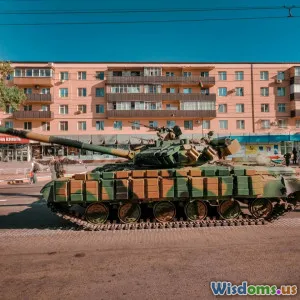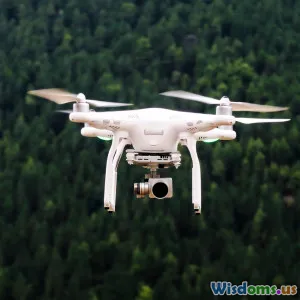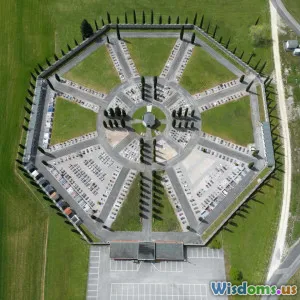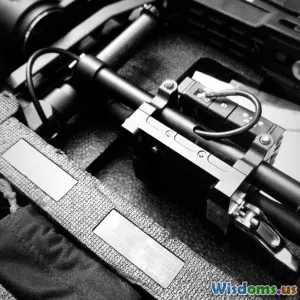
Top Five Emerging Autonomous Tanks Changing Warfare
9 min read Explore how five groundbreaking autonomous tanks are revolutionizing modern warfare with cutting-edge AI and robotics technology. (0 Reviews)
Top Five Emerging Autonomous Tanks Changing Warfare
Introduction
The future of warfare is no longer a distant concept confined to science fiction; it is rapidly unfolding on the battlefield with autonomous military systems taking center stage. Among these transformative technologies, autonomous tanks stand out as a symbol of modern mechanized combat innovation. These vehicles are no longer just machines driven by human crews; they represent a new class of intelligent warriors, capable of operating semi-independently or fully autonomously. This article explores the top five emerging autonomous tanks reshaping how armed forces engage and strategize in combat zones worldwide.
The trend towards autonomy in armored warfare is driven by advances in artificial intelligence (AI), robotics, sensor technologies, and networked battlefield communications. The goal is to create lethal, adaptable, and survivable platforms that reduce human risk while exponentially enhancing battlefield effectiveness. These tanks are expected to operate in swarm formations, perform reconnaissance, provide precision fire support, and execute coordinated attacks—all with minimal human intervention.
The Rise of Autonomous Tanks
Historically, tanks have been vital assets due to their firepower, protection, and mobility. However, manned operations expose crews to significant risks including detection and enemy fire. Autonomous tanks mitigate these risks by removing soldiers from direct danger, while simultaneously enabling faster decision-making through AI-assisted targeting and navigation systems.
Emerging autonomous tanks integrate sensors such as LiDAR, infrared, radar, and optical cameras alongside machine learning models that analyze terrain, detect enemy forces, and plan optimized maneuver paths. Combined with high-speed communications, these vehicles are transforming the fluid dynamics of frontline combat.
1. Goliath-X: The US Next-Gen Scout Tank
Developed under the U.S. Army's Robotic Combat Vehicle (RCV) program, the Goliath-X aims to perform high-risk reconnaissance missions. Weighing under 12 tons, it is lighter and faster than traditional tanks, capable of operating autonomously in complex terrains.
Features and Capabilities:
- AI-powered target recognition and engagement capabilities.
- High mobility with all-terrain navigation.
- Swarm coordination allowing multiple Goliaths to operate as a single fighting unit.
According to Colonel James Peterson, RCV program lead, "Goliath-X provides real-time battlefield intelligence without risking soldiers. Its autonomous operation ability means it can outmaneuver enemy threats swiftly."
Operational Use Case: In field exercises at Fort Hood, Texas, Goliath-X demonstrated success in nocturnal reconnaissance missions detecting simulated enemy installations beyond human scout ranges, proving its tactical value.
2. Russia’s T-14 Armata Autonomous Variant
The advanced T-14 Armata platform has entered development pipelines to include an autonomous variant that melds heavy armor with AI-assisted target acquisition and autonomous movement.
Highlights:
- Fully digitalized turret control and fire management.
- Integrated conditioning AI for threat detection.
- Capable of configurable autonomy levels from remote operation to full autonomy.
Combat journalist Svetlana Ivanov notes, "The T-14’s autonomous upgrades signify a clear step in modernizing Russia’s armored forces, focusing on crew safety and battlefield efficacy."
While the Armata's autonomous combat launch timeline remains sensitive, its technology infusion promises a strategic advantage in future armored confrontations.
3. Israel Defense Forces’ D-ETS Autonomous Armored Tank
Israel’s Defense Technology & Systems (D-ETS) division pioneers merging autonomous tech with veteran tank designs. Their autonomous armored platform leverages decades of real-world combat experience.
Distinct Attributes:
- Advanced threat identification through multidisciplinary sensor fusion.
- Independent tactical sequencing to coordinate with manned units.
- Enhanced anti-missile countermeasures leveraging AI pattern recognition.
Col. Yossi Bar-Lev, defense specialist, asserts, "The D-ETS system equips the IDF with tactical versatility and precision. Autonomy here complements human decision-making for rapid strike capacity."
Its deployment in border security and potential urban combat missions underscores versatility beyond traditional open-sky armored engagements.
4. China’s AV-4 Autonomous Battle Tank
China is betting heavily on autonomous armored warfare with its AV-4 prototype, designed for large-scale formations and integrated electronic warfare tactics.
Key Innovations:
- Networked AI nodes enabling cooperative engagement strategies.
- Autonomous target prioritization algorithms backed by battlefield data analytics.
- Stealth-oriented chassis with active camouflage systems.
Military analyst Li Wei highlights, "AV-4 is engineered for a digitized battlefield scenario where rapid data exchange and collectively coordinated autonomous units prevail."
Simulations suggest AV-4 could disrupt conventional combat formations by rapidly adapting to evolving threats with minimal human input.
5. India’s Arjun Mk II Autonomous Prototype
India’s Arjun Mk II tank undergoes an ongoing renovation aimed at autonomous functionalities to bolster the mechanized units of its armed forces.
Development Focus Areas:
- Automation of turret and gun operation guided by AI.
- Semi-autonomous navigation to handle difficult mountain and desert terrains.
- Integration with drone reconnaissance for joint battlefield awareness.
Major General Ranjit Singh comments, "The move towards autonomous Arjuns reflects India’s commitment to modern defense doctrines emphasizing automation and digitization to neutralize emerging threats efficiently."
Its ruggedness in hostile environments and evolving autonomy aligns with India’s strategic doctrines for border defense.
Defining the Future Battlefield
These autonomous tanks represent a paradigm shift where AI and robotics effectively become force multipliers—enhancing situational awareness, survivability, and firepower efficiency. As autonomy systems mature, collaboration between human commanders and intelligent vehicles will evolve, potentially leading to faster, more precise operations and reduced casualties.
Challenges Ahead:
- Cybersecurity risks targeting autonomous control systems.
- Ethical debates around AI lethal decision-making autonomy.
- Integration complexity with existing military infrastructure.
However, investing in robust control assurance, encryption, and stringent operational protocols mitigates many concerns.
Conclusion
The emergence of autonomous tanks marks a pivotal chapter in military technology, highlighting how robotic intelligence intersects with traditional armored warfare. Vehicles like the Goliath-X, T-14 Armata autonomous variant, D-ETS, China’s AV-4, and India’s Arjun Mk II demonstrate global momentum toward automated firepower, enhanced survivability, and multi-domain operations.
Understanding these systems is crucial for defense analysts, strategists, and policymakers shaping the next decades’ combat environment. Far from replacing soldiers, autonomous tanks will complement human forces, opening new tactical horizons and transforming the art and science of war.
The continued evolution in this domain promises to shift battlefield narratives with smarter, faster, and more decisive armored units tailored to future conflict scenarios.
References & Further Reading:
- US Army Futures Command Reports, 2023
- Jane’s Defense Weekly: Autonomous Combat Vehicles, April 2024
- Defense News: "Russia’s Armata Upgrades" March 2024
- Israel Defense Forces Technology Bulletins, 2023
- South China Morning Post: "China's Next-Gen Robotic Tanks," January 2024
- Indian Defence Review: "Arjun Tank Modernization," December 2023
Rate the Post
User Reviews
Popular Posts



















